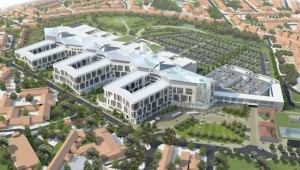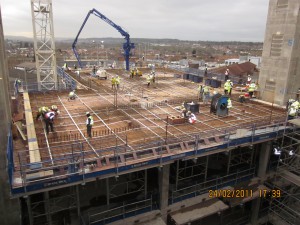Freyssinet undertook a significant post-tensioning slab project at Southmead Hospital. Located in Bristol and owned by the North Bristol NHS Trust, the site was chosen for a major re-development and extension of its facilities in 2005, with several specialties and services to be centralized in one location.

Following the successful completion of various other projects, including the Olympic Media Centre and Knightsbridge Palace Hotel, frame contractors Byrne Bros once again chose to collaborate with Freyssinet to supply and install the post-tensioned system.
The £430 million hospital project will consist of five key zones, one helipad and two car parks. The space is arranged with a spine; to the west of the spine are a series of nine fingers which accommodate the main clinical functions (X-ray, operating theatres, MRI scanners, etc). They are formed by a post-tensioned concrete frame up to seven storeys tall. Abutting the east of the spine are three steel framed ward blocks, being designed to catch as much natural light as possible.
The concrete building is 233m long by 59m wide on average. Two permanent movement joints divide the length into three blocks with the largest being 106m long. The frame is braced by four main concrete cores and several other discrete concrete walls. The cores are being slip-formed and the columns are precast. The structural grid varies across the floor space to suit the usage requirements but it reaches 9.2m by 9.1m in several locations. A standard slab thickness of 350mm was adopted generally across the structure. More substantial steps to accommodate scanners, roof terraces and the like, requires a local step in the soffit. An average floor level is split into nearly 20 pours of typically 225m3 or 650m2 each. Typical loadings are 4kN/m2 for live load plus 1kN/m2 for partitions with an additional 1kN/m2 for superimposed dead load. Live loads increase to 7.5kN/m2 in plant rooms. The slabs are being post-tensioned using the 4B15 bonded flat slab system with tendons spaced at an average of 1.4m centres in both directions. They are partially stressed the day after the pour in order to part-compress the slab, helping to prevent early age cracking of the concrete. Full stress is applied after the concrete has achieved 25MPa cube strength.

The soffits of the slabs are being painted with lines to show the as-built location of tendons. This will aid the positioning of future penetrations and fixings into the soffit.
The total area of post-tensioned concrete floor slab is approximately 54,000m2. The building contains in the order of 300 tonnes of PT. The environmental aims of the Southmead Hospital project are aided by the use of post tensioned concrete slabs, due to the savings of approximately 25% of concrete and 65% of steel compared to conventional methods. Furthermore, the reduced concrete and steel quantities in a post tensioned slab have a direct benefit on decreasing the number of deliveries and hence vehicle movements on the site, which contributes to both environmental and safety benefits. Programme, costing and logistical benefits are also realised, with reduced hook time for cranes and minimised storage space required on site. The structural challenges of hospitals – vibration performance, flexibility for penetrations and location of setdowns in the slab surface – have all been readily accommodated in the design and construction.
Bob Lloyd, Project Director for Byrnes Bros, said: “Progress on the post-tensioning has been really good. The Byrnes Site Manager and the Freyssinet Supervisor have weekly meetings to agree the priorities, work sequence and resource level for the week and, as a result, the two teams work terrifically well together”.
The new, state-of-the-art hospital is programmed to open its doors in 2014 with completion of the car parking and landscaping in 2015.
